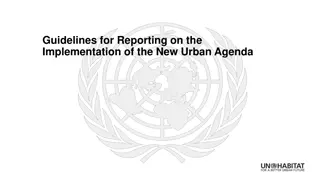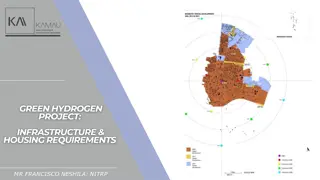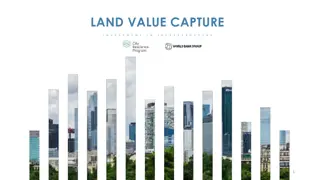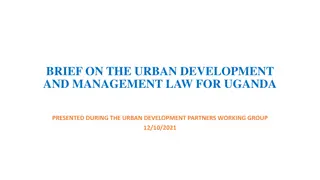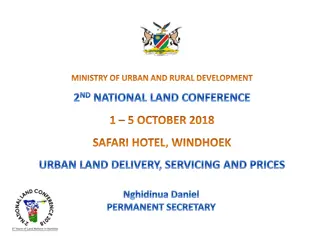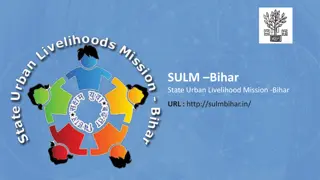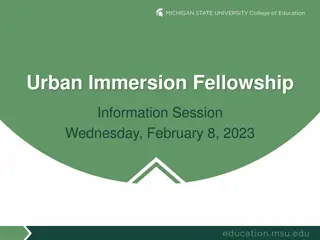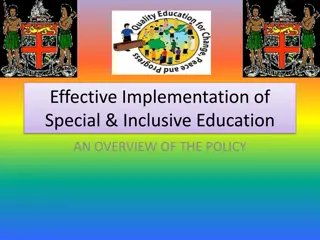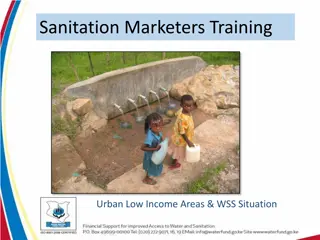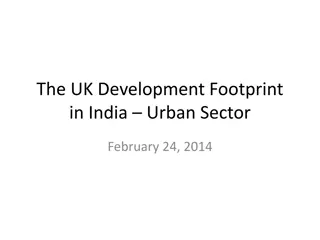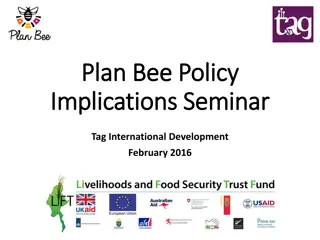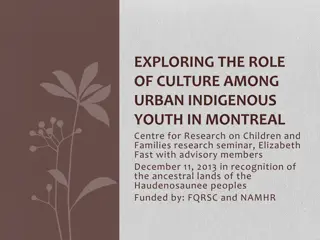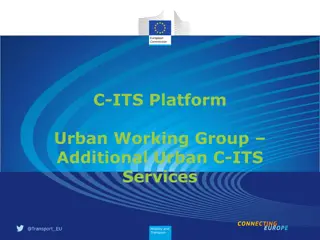Inclusive Urban Infrastructure Policy Seminar Overview 24th February 2022
This seminar discusses urban infrastructure challenges in the context of rapid global South urbanization, focusing on differential service access patterns, trajectories of inclusion, and interventions to address inequality. Research objectives include understanding infrastructure access in off-grid housing areas and developing equitable provision strategies for excluded residents.
Download Presentation

Please find below an Image/Link to download the presentation.
The content on the website is provided AS IS for your information and personal use only. It may not be sold, licensed, or shared on other websites without obtaining consent from the author.If you encounter any issues during the download, it is possible that the publisher has removed the file from their server.
You are allowed to download the files provided on this website for personal or commercial use, subject to the condition that they are used lawfully. All files are the property of their respective owners.
The content on the website is provided AS IS for your information and personal use only. It may not be sold, licensed, or shared on other websites without obtaining consent from the author.
E N D
Presentation Transcript
Inclusive Urban Infrastructure Policy Seminar Kudzai Chatiza and George Masimba 24thFebruary 2022 Rainbow Towers Hotel, Harare
24.2.2022 Seminar Overview The seminar objectives are to: 1. Update stakeholders on research progress, 2. Share preliminary findings, and 3. Receive community and stakeholder feedback as necessary. The interactions around these objectives will inform the next steps towards conclusion of the study by March 2023.
24.2.2022 Context: Fast Global South urbanisation 1. Global population growth estimated to be mainly in African and Asian cities. SSA urban population grew from 36% to 41.25% (5.25%) from 2010 to 2020 with Zimbabwe sliding from 33.2% to 32.2% (-1%) over the same period (https://www.statista.com/statistics/805657/urbanization-in-sub-saharan-africa/) 2. Developing countries rapid urbanisation is in context of climate change, economic challenges [weak economies], strained governance & disasters. 3. Clear path: Agenda 2030 (SDGs, V2030), Constitution, policies, laws, and strategies (e.g. NDS 1) seek equitable and sustainable development 4. That cities are brutally unequal & poverty has risen faster in urban than rural Zimbabwe recently little understood. Policies not adequately informed by this reality 5. Housing Tenure Security is a key urban challenge which shapes and is shaped by state decisions on whether and how infrastructure is extended to off-grid settlements
24.2.2022 Research Objectives, Questions & Audiences Research Objectives 1. Establish differential service access patterns 2. Identify trajectories of inclusion (by grid) 3. Develop interventions to address inequality of provision Research Questions 1. How are key infrastructures (of WASH, energy, transport & communication) accessed and services consumed by people living in off-grid housing areas? 2. How do systems of provision for these five infrastructure grids vary between each service and between different areas? 3. How can provision be extended in an equitable manner to residents that are currently excluded? Local, Provincial/Metropolitan and National Government Residents of relevant settlements Members of the general public Local, National, International Organisations and Donors supporting initiatives in the targeted settlements Private sector organisations involved in infrastructure and service development i.e. housing/land, water, sanitation, energy, communication and transport Researchers and Academics
24.2.2022 Sites for Research Implementation 4 states, 6 cities: Zimbabwe, Somaliland (Africa), Sri Lanka and Bangladesh (Asia) Zimbabwe: Harare (4 settlements) and Masvingo (2 settlements) Targeted Sites: Size of between 1000 and 5000 households with 2 picked from the Unknown City Research Project (2016-2018) Harare: Budiriro 5 Extn, Churu Farm, Hatcliffe Extn, and Hopley Masvingo: Old Mucheke and Victoria Ranch
24.2.2022 Research Design & Methods by Question Question 1: Infra access & service consumption Question 2: Systems of Provision & their variations Question 3: Extending provision equitably FGD sessions @ least 3 per site Large household survey at least 10- 20% of households capped at 2-3000 Panel Survey @ least 10% of those surveyed (to be done later) Interviews with residents (detailed qual) to map SsOP approach up to 50 per site (86/300 done so far) Community profiling parallel to empirical work & in historical context (ongoing) Key Informant Interviews responsible for urban governance Photovoice with 30 participants (residents and key informants): photos, photo-based interviews & perspectives workshop Stakeholder Meetings Comic Book Methods (smaller number of interviewees co- developing visual details of their experiences with PositiveNegatives help) Supported Interventions i.e. productive interventions to tackle identified barriers 16 FGD sessions (152 px), 3132 survey respondents (Report p11). Median age 32 years. 64% always residents of the areas
24.2.2022 Preliminary Findings: Profiles & FGD Insights 1. 2. New to aged settlements, 6yrs (CF), 17yrs (H, BE & VR), 29yrs (HE) & 130yrs (OM) All experience slow, contested to standstill infrastructure and service transitions. This makes for poor services. Areas are prone to disasters Although not chosen for the study education & health grids are acutely under-provided. Only OM better on health and education, H on health Approval & completeness of housing variable. Lowest in CF & H while upgrading is overdue in OM (partly underway) Incompletely arrayed land admin with vague & fluid role and structures for local & national government as well as local organizations (LO s). LO number & mix highest in VR making for complex planning-management (& is least in OM) Diverse and stabilizing resident population. H is most diverse & populous. Most experience localized displacements, informal occupations & normal exits/entries 3. 4. 5. 6.
24.2.2022 Preliminary Findings: Security of Tenure On 18% with Title Deeds 1. OM s 53 of 352 (15%) is credible given post- 1980 homeownership policy 2. 151/554 in VC (27.3%) is legally impossible 3. This is possibly the case for H s 32/921 (3.5%), CF s 3/432 (0.7%) & BE s 53/464 (11.4%) 1. Considerable security: 64% of respondents have always been residents of areas. 49% feel state protection from eviction is likely. 47% have a land/housing document (VR & HE top @59% with CF least @32%). Diversity of land/housing documents : 33% Certificates , 30% Leases (Council & National Gvt), 10% utility bills, 18% Title Deeds with the remainder being rental contracts, party letters and caretaking agreements Only 26% got land/housing from the state (local/national) directly. 10% bought. Remainder (nearly 2/3) were allocated through LO s. This may explain paperwork diversity & limitations. It also shows how settled alternative models have become The findings extend the classic notions of land/housing tenure security 2. 3. 4.
24.2.2022 Preliminary Findings: Extent of Self-Provisioning 1. Above 40% of residents of the areas provide their own water and sanitation. State provision is higher for sanitation @ 36% and lower for water at 22%. Neighbors (shared services), NGOs, and local private sector make up the difference for both Except OM the other settlements are not yet on the national electricity grid. (87% off-grid). For cooking fuelwood tops @48% followed by LPG @37% while for lighting solar tops @46% followed by 25% candles 48% of respondents were unsatisfied with transport, 41% satisfied and 11% on the fence . Bus-based public transport (ZUPCO s) is limited due to poor state of roads Mobile telephony is at 61% with 49% using their devices to access the internet and 78% access phone- mediated financial services Extent of self and state provision of WASH 50 45 2. 40 35 30 25 3. 20 15 10 5 4. 0 % Self-provision % State-provision Water Sanitation
24.2.2022 Emerging Messages 1. There is substantial level of settledness. Residents are not overly anxious. They are counting the years 2. A good foundation of self-provisioning established across different grids for state to build on. Energy grid easier than WASH 3. Multiple forms of papers for securing tenure successfully piloted but with some limits especially regarding scaled & inclusive extension of particular grids 4. Inadequacy of state facilitation a product of fragmented public sector 5. The presence of an institutional void that the state can occupy and help catalyse and regularize infrastructure provision 6. Variable sustainability & performance of local/settlement organisations largely inevitable in environments of inadequate state facilitation
24.2.2022 Preliminary Policy Implications 1. Defining and updating appropriate land/housing paperwork . This may appropriate alternative/intermediate versions in use 2. Inclusive mobilizing of LO s by the state around infrastructure and service expansion models suited to different settlements and social groups within individual settlements 3. Harnessing massive financial investments currently being directed towards informal services through carefully modelled improvements initiatives Dimensions of Infrastructure Inclusion 1. Choices on design & tech standards 2. Delivery models & financing options 3. Institutions involved (local to national) 4. Legal land/housing access options 5. Leaving no one behind Defining infrastructure completeness 1. As per approved tech designs (original &/or revised) related to policy & law 2. For meeting basic needs of decency, safety, ease of use & management 3. Wide accessibility, affordability & acceptability 4. Clarity of progression/upgrading path involve consolidating state-led infrastructure





